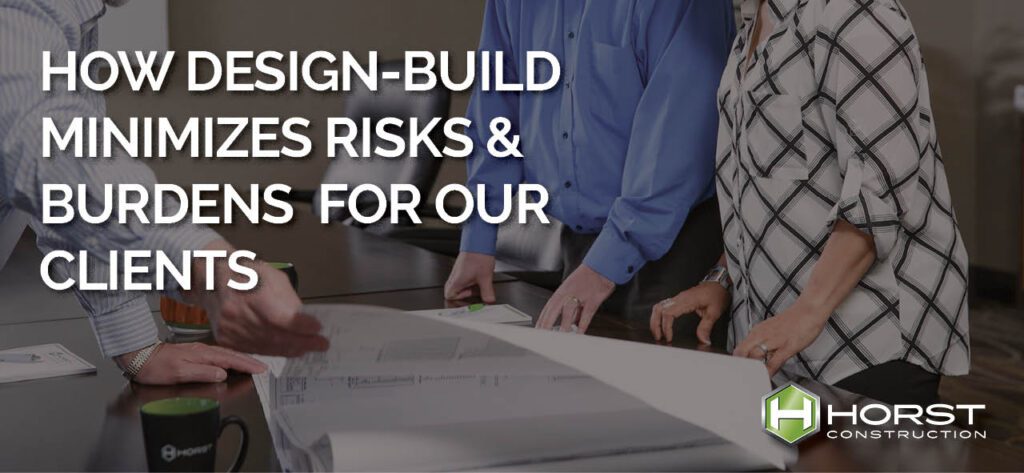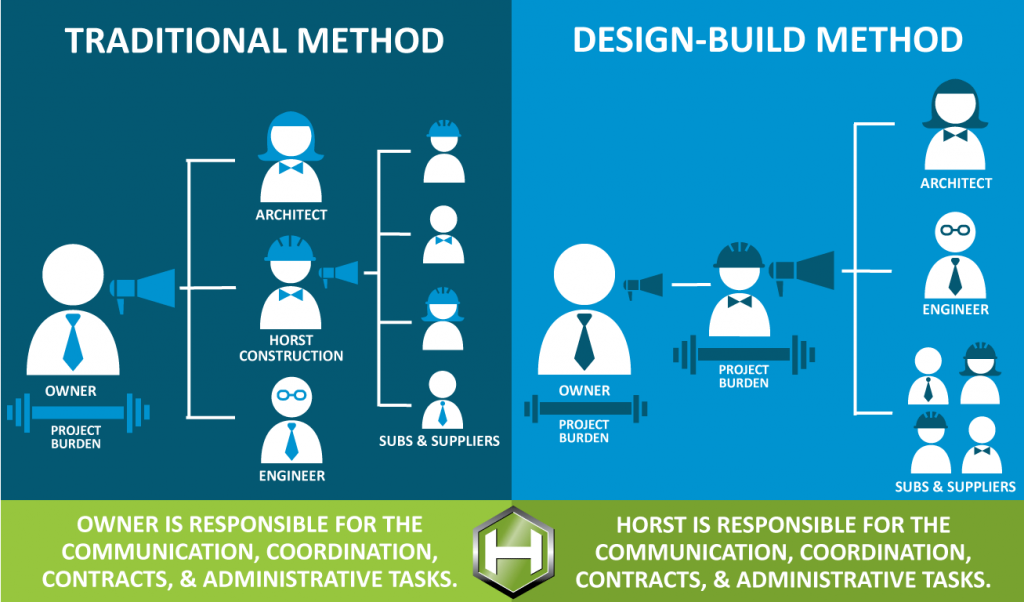How Design-Build Minimizes Risks & Burdens for Our Clients

The design-build project delivery method has become the option of choice for most construction projects in recent years. In addition to consistently delivering projects more quickly and for less money compared to methods like design-bid-build[i], the approach also has two major benefits for project owners: it reduces their risk and burden.
In this blog, we’ll take a closer look at how these two benefits not only make the project easier for the owner but also results in a better building.
What is Design-Build?
In short, design-build is a project delivery approach that unites every contractor and partner around one shared goal: the success of the project as a whole. Because the construction and design partners are united under a contract, their success depends on the project’s outcome as a whole instead of solely their individual portion.
Instead of the owner managing contracts and communication with the contractor and designers, they’ll only have one with the design-build entity. But that doesn’t mean you as the owner will have less control over the project.
This method translates to a more well-rounded project design that incorporates major disciplines in the process from the beginning. The architectural partner and design-build partner will work collaboratively from the start to capture a design that marries the owner’s vision and budget with functionality, constructability, and operational considerations.
To learn more about the design-build project approach, check out this blog.

How Design-Build Mitigates Owners’ Risk
From unforeseen site conditions to defective materials and constructability issues, a construction project does have some inherent risks. As the owner of the project, you’re footing the bill, and traditionally, shouldering much of the project’s risk.
But with a design-build project approach, you’re able to shift much of this risk onto the contractor or a design-build entity for fair compensation. But that doesn’t mean a design-build project is more expensive. In fact, because of the inherent efficiencies and enhanced communication, design-build projects are consistently less expensive and faster than other project delivery methods[ii].
This is because of the design-build team’s structure. The only contract you as the owner will hold is with the contractor or design-build entity. The design-builder will then hire all the subcontractors and partners on the project. These teams will answer directly to the design-builder, and the design-builder will shoulder much of the risk associated with those partnerships, including design.
With other project delivery methods like design-bid-build, the owner takes on the design contract, and shoulders the risk associated with that. The contractor is only responsible for their portion of the project.
There will still be some risk you’ll bear with design-build, and other risks you’ll share. Specifics will vary from contract to and team to team. According to a study conducted by the Southern Polytechnic State University, design-build teams typically split risks into the following:[iii]:
| Risks Often Transferred to the Design-Build Entity | Risks That Typically Stay With the Owner |
| Defective materials | Site access |
| Quantities of work | Differing site conditions |
| Quality of work | Delayed payment on a contract |
| Safety and accidents | Permits and ordinances |
| Contractor competence | Unidentified utilities |
| Establishment of project cost | Changes in work |
| Labor disputes | Acts of God |
| Defective design | Government acts and regulations |
| Defensive engineering |
The study mentions that risks that aren’t listed here are typically shared between the design-builder and the owner. It’s also important to keep in mind that the above breakdown won’t necessarily be indicative of your project. You and your team will decide what works best for your needs, as the strength of the design-build approach is assigning risks based on the best party to mitigate these challenges.
The design-build team, as a conjoined entity with the contractor and project designers, are in the best position to advise and effect change on the latter risks, decreasing the likelihood they’ll interfere with the project’s budget or schedule.
How Design-Build Lessens Owners’ Burden
A construction project will demand some level of involvement by the project owner. Be it attending regular meetings, oversight, review, or something else, it will take time and effort to take the project from conception to completion.
At Horst Construction, we strive to tailor owner involvement in our projects to the specific preferences of our clients, regardless of project approach. However, the design-build delivery method makes doing this easy.
This starts out by making the flow of communication to and from the owner more efficient. Instead of being bombarded with requests, questions, and more from several of the project’s partners, you’ll only have one point of contact – the design-builder. This change doesn’t remove you from weighing in on important decisions or knowing essential information. Instead, it frees you from the role of the “middleman.” You’re not responsible for brokering communications between parties, the design-builder will take on that role.
Additionally, the design-builder will take on some of the essential tasks that can often take up a good deal of the owner’s time, like team coordination, paperwork, documentation management, and more.
Does Design-Build Limit Owners’ Power Over the Project?
Surely the concepts of limiting the project’s risk and burden sound appealing. But with that, does design-build require owners to relinquish their power over the project?
This is a common concern owners have with this project approach. However, this shouldn’t be the case.
By shifting much of these tasks to the design-builder, you as the owner are not losing power or control over the project. Instead, it’s freeing up your time and resources to focus on the r aspects of the project that are most important to you.
At Horst Construction, our primary focus is to deliver our client’s ideal building in their ideal environment. We’ll tailor our approach and communication style to suit our client’s preferences. If they’d like full insight into each decision, we’ll facilitate that — design-build contract or not. If they prefer to limit things to a higher level, we can work that out as well.
Design-build gives owners the ability to choose how much — or how little — they’re involved. It also frees them from the more mundane project-related tasks so they can focus instead on the more important tasks and decisions.
Is Design-Build Right for Your Project?
Design-build can be an effective approach for projects of all sizes. Not only is your project more likely to cost less and be completed more quickly, but you as the owner will be exposed to less project-related risk, and you’ll be able to shift much of the time-consuming burdens to your design-builder.
That said, this team structure isn’t for everyone on every project. We’ve created a short quiz that will help you determine which is the best project delivery method for your project. Click the link below to take it now!
[i] https://www.construction-institute.org/resources/knowledgebase/project-phases/procurement/topics/rt-133
[ii] https://www.construction-institute.org/resources/knowledgebase/project-phases/procurement/topics/rt-133
[iii] http://ascpro0.ascweb.org/archives/cd/2008/paper/CPRT235002008.pdf
Posted June 14, 2023

